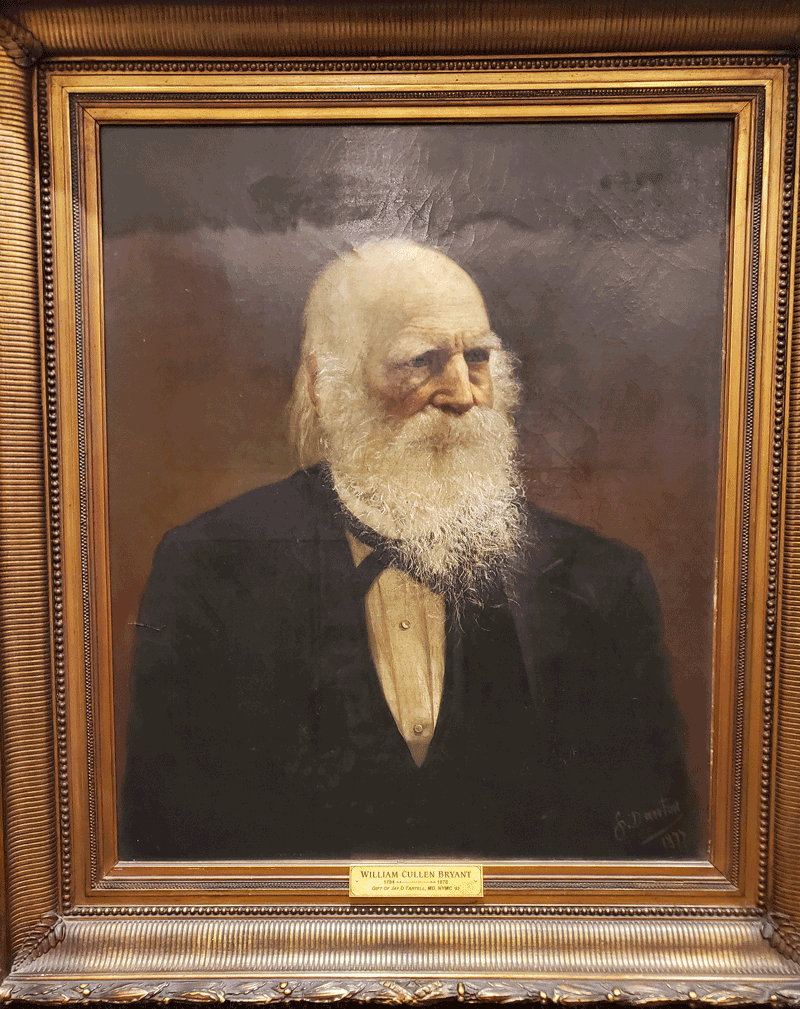New York Medical College Proudly Displays Donated Portrait of William Cullen Bryant
Historical Portrait of NYMC Founder and Longtime President of the Board of Trustees Adorns Medical Education Center

New York Medical College (NYMC) co-founder and revolutionary, William Cullen Bryant, is back at the College–in oil painting form. The portrait of the long, gray-bearded founding father is hung prominently in the Blanche and Albert Willner, M.D. '43 Atrium and Lobby in the Medical Education Center, where hundreds of students pass each day and can now be inspired by the man who laid the College’s foundation. Jay D. Tartell, M.D. ‘82, gifted the College “Portrait of William Cullen Bryant,” which was painted by Ferdinand Danton Sr., in 1877.
"William Cullen Bryant’s often forgotten contributions to the ascent of America and the vitality of New York need to be understood and remembered today,” said Dr. Tartell in a statement. “Bryant’s role in the founding of NYMC is of obvious interest to the College community. But his role as a ‘Renaissance Man,’ advancing our country on multiple fronts – including science, art, politics, literature, world awareness and moral principles – can serve as an even greater inspiration to our students.”
Born in Massachusetts, Bryant (1794-1878) rose to literary fame with the publication of his poem “Thanatopsis” in 1817. The poem he wrote at just 17 years old distinguished him as one of the most notable American poets and authors in history. In 1825, he left his hometown and traveled to New York City, where he would put down roots as the co-editor of the New York Review and soon after, the co-owner and editor-in-chief of the New York Evening Post for 50 years.
Co-founder of the Republican Party, Bryant advocated the abolition of slavery. On February 27, 1860, he introduced Abraham Lincoln of Illinois at his first public address in New York City. Lincoln’s “Cooper Union speech” effectively launched his successful campaign for President of the United States. Less than two months after the speech, on April 12, 1860, the founding charter of NYMC was approved by the New York State Legislature.
William Cullen Bryant was an early supporter of the College and spoke and wrote frequently on its behalf. He assumed the presidency of the Board of Trustees in 1862 until his death in 1878. As a New York civic leader, Bryant also played major roles in the establishment of Central Park, the Metropolitan Museum of Art and what is now NYC Health + Hospitals/Metropolitan.
“William Cullen Bryant thought the great oppressors of Americans were racism, sexism, alcoholism and income inequality,” said Edward C. Halperin, M.D., M.A., chancellor and chief executive officer. “He had a four-pronged solution to this four-pronged problem – emancipate all enslaved people and grant them the vote, women’s suffrage, temperance and allowing workers to form trade unions and collectively bargain with management. These were very progressive views for the 1850s and1860s. But these views helped create the institutional culture of NYMC when he founded it in 1860. We are proud to acknowledge our heritage and have this portrait of our founder ‘back home.’”
This portrait, painted in 1877, by Ferdinand Danton, Sr. (1850-1912), a well-known contemporary painter of portraits and religious subjects, depicts Bryant in the final years of his life. A descendant of French revolutionary Georges Danton, he was born in France and studied painting in Paris before emigrating to the United States in 1869. In 1905, Danton became the founding chair of the Department of Art at Fordham University.
